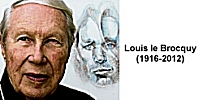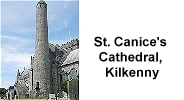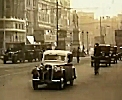|
KEEP THIS NEWSLETTER ALIVE! GOT A WEDDING OR BIRTHDAY COMING UP? Shop Online at https://www.irishnation.com |
|

Marvellous Gifts! Family Crest Shields |

Display your Heritage: Family Crest Flags |

=============
IN THIS ISSUE
=============
=== News Snaps from Ireland
=== New Free Resources at the Site
=== Ancient Ireland #2: The Tuatha de Danann
=== Reading the Irish Landscape by Andrea Santillo
=== Inishmore - a poem by Lisa Bertram
=== YouTube Videos of Irish Interest
=== Gaelic Phrases of the Month
=== Monthly Free Competition Result
Popular Articles from recent Newsletters:
Ancient Ireland #1: The Milesians
35 Things You Never Knew About Dublin
The 1916 Easter Rising
The Flight of the Earls
A Trio of Famous Irish Painters
The Hynes Family of Ireland
General Michael Collins
==========
FOREWORD
==========
The talk here in Ireland is all about the upcoming
'Fiscal Treaty' Referendum. The Irish electorate
has a history of rejecting government proposals that
are not fully explained or if they wish to teach
their masters a lesson! Although opinion polls show
overall support for the Treaty the number of those
still on the fence is massive and it is these voters
who are sure to make the difference. The stakes are
high and it is now 'Game On!'. The vote is at the
end of May.
Enjoy your FREE Ireland Newsletter!
Michael
P.S. Please DO FORWARD this Newsletter to a
friend or relative. If you have a website or Facebook
page or Blog (or whatever!) then you can help
us out by putting a link on it to our website:
www.ireland-information.com
Do tell your friends about us as this helps
to keep this newsletter free!
WE NEED YOUR HELP - CONTRIBUTE!
Got something to say? Don't keep it to yourself!
Why don't you submit an article for inclusion
in the next edition? Go here for more information:
https://www.ireland-information.com/newsletter.htm
Do you have access to a website? You can help to
keep this newsletter alive by adding a link to
any of our websites below:
https://www.irishnation.com
http://www.irishsurnames.com
https://www.ireland-information.com
http://www.allfamilycrests.com
http://www.irishpenpals.com
If you have an AOL or HOTMAIL account then you
may get better results by viewing this
newsletter online here:
https://www.ireland-information.com/apr12.htm
The only way that you could have been
subscribed to this newsletter is by filling
out a subscription form at the site whereupon
a confirmation notice would have been issued.
If you wish to unsubscribe then go here:
https://www.ireland-information.com/newsletter.htm
========================
NEWS SNAPS FROM IRELAND
========================
|
EUROPEAN JITTERS MAY SCUPPER IRISH TREATY APPROVAL Recent events in France and The Netherlands may combine to influence the outcome of the crucial May vote on the EU Fiscal Treaty. The prospect of the defeat of Nicolas Sarkozy in France by Socialist Francois Hollande has put the spotlight on the plans within the EU and in particular Germany's insistence on austerity as being the way out of the current crisis. Mr. Hollande is quoted as saying 'Either there will be a new treaty or there will be a modification of the existing treaty. It's about negotiation.' 
Ireland is currently implementing Draconian austerity measures with huge increases in taxes being coupled with severe cutbacks in services. Should the French elect a new leader who is demanding a revision of the Treaty that Ireland is about to vote on then it will be next to impossible for the Irish government to convince its citizenry to approve it. Developments in The Netherlands have also rocked the European establishment with one of the Eurozone's most stable governments collapsing under the weight of the austerity burden. How can the Irish electorate realistically vote in favour of a Treaty that may be changed dramatically should the French and Germans decide? Rejecting the Treaty would have as yet unknown repercussions for Ireland with the doom-sayers indicating that the country would be refused any future 'debt crisis' funding while those who want the Treaty ditched see any defeat as a path towards Ireland leaving the Euro currency (whether by choice or design). Fianna Fail, Fine Gael and Labour all support the Treaty while Sinn Fein, the Socialist Party and the coalition of independents oppose it. Individual Trade Unions have already being advising their members to reject the Treaty, much to the embarrassment of the Labour Party. It seems that the vote is also likely to be used as a whipping tool to punish the government for its recent mishandling of various policy initiatives including the introduction of water charges, the new property tax and even septic tank and turf-cutting measures. An unlikely alliance of left-wing causes could fuse with popular mainstream opposition to yet more austerity to give the Fine Gael and Labour Government a bloody nose. MAJOR IMPROVEMENT OF MATER HOSPITAL IN DUBLIN The pivotal Mater Hospital in Dublin has been expanded with the imminent opening of new state-of-the art operating theatres, 120 one-bed rooms, as well as a vital new emergency and out-patients department. The Mater hospital is one of the busiest in the country and the improvements will come as a great boost for staff and patients alike. 
The decision regarding the location of the new national children's hospital has still to be made after the original plan to locate the new hospital adjacent to the Mater Hospital was rejected by the Irish planning authorities. Despite this setback it is expected that a scaled-down version of the original plan may yet see the development go ahead, turning the Mater Hospital site into perhaps the most important health-care facility in the country. ECONOMY STILL IN DOLDRUMS DESPITE TECH JOBS BOOST Despite the high profile jobs boost from companies such as Apple and Google, the depth of the economic situation in Ireland has again been brought into sharp focus by the release of some pretty startling statistics: * Unemployment in 2006 was 4.3%, by 2012 it was over 14%. * Just recently over 10,000 people applied for a mere 600 Army and Navy jobs. * An illustration of the severity of the construction industry crash has highlighted the fact that in 2006 house completions numbered 90,000 while in 2011 the figure was just less than 10,500. 
PRIVATE HOMES TO PAY FOR WATER Fresh on the heels of the property tax debacle the government has announced its plans for the taxation of water usage in Irish homes. In Ireland businesses already pay for water usage but private houses do not, the funding for which comes from general taxation revenue. The new plans to install a water meter in every house in the country have, like the property tax, been greeted with dismay by a population groaning under the weight of an already huge tax burden. It is expected that average annual usage would cost approximately 400 euro, with heavier users paying more. It is broadly accepted that there is a case for charging for water usage. Estimates put the wastage of usable water at over 50% from the country's creaking and in some cases Victorian water pipes network. Owners of rural houses often have to sink their own well or else join a water scheme while urban houses do not have any such expense. Taxpayers can however, reasonably argue that they already pay for water in their income and sales taxes so why should they pay again? LABOUR PARTY UNDER PRESSURE The new water charges are another touchy issue for the Fine Gael government but particularly so for its coalition partner, the Labour Party. Elected as an advocate of the working class, the party is taking a huge risk by: * supporting the introduction of the property tax * supporting a new water charge * supporting the EU Fiscal Treaty 
Sinn Fein seem best placed to benefit in the next election, gleefully predicting that the Labour Party will be destroyed with their assuming the mantle of the true party of the working class. A recent opinion poll puts Labour on 13%, Fianna Fail on 14% and Fine Gael on 33%. The real news though is that Sinn Fein are on 22%, easily making it the second most popular party in the country. Labour are very much on the back foot. DEATH OF IRISH ARTIST LOUIS LE BROCQUY The death has occurred of the prominent Irish artist Louis le Brocquy. He was aged 95. He was best known for his portraits of literary and artistic figures including Francis Bacon, Samuel Becket and Seamus Heaney. 
|
===============================
NEW FREE RESOURCES AT THE SITE
===============================
IRISH HOLIDAY AND TOURIST FORUM
Post your question about holidaying in Ireland and
we guarantee an answer will be posted on the board:
https://www.ireland-information.com/irishholidays-irishtourist/irishtouristboard.html

NEW COATS OF ARMS ADDED TO THE GALLERY
The following 5 coats of arms images and family
history details have been added to the Gallery:

C: Cashion, McClinton
N: McNicholas
W: Watson, Whitney
View the Gallery here:
http://www.irishsurnames.com/coatsofarms/gm.htm
THE PERFECT WEDDING, ANNIVERSARY OR BIRTHDAY GIFT!
We now have over 100,000 worldwide names available.
Get the Coat of Arms Print, Claddagh Ring,
Screensaver, Watch, T-Shirt Transfer or Clock for
your name at:
https://www.irishnation.com/familycrestgifts.htm
================================
ANCIENT IRELAND #2: THE TUATHA DE DANANN
=================================
|
The Tuatha de Danann, the people of the Goddess Danu, were one of the great ancient tribes of Ireland. The important manuscript 'The Annals of the Four Masters', records that they ruled Ireland from 1897 B.C. to 1700 B.C. The arrival of the tribe in Ireland is the stuff of legend. They landed at the Connaught coastline and emerged from a great mist. It is speculated that they burned their boats to ensure that they settled down in their new land. The rulers of Ireland at the time were the Fir Bolg, led by Eochid son of Erc, who was, needless to say, unhappy about the new arrivals. 
The Tuatha de Danann won the inevitable battle with the Fir Bolg but, out of respect for the manner in which they had fought, they allowed the Fir Bolg to remain in Connaught while the victors ruled the rest of Ireland. The new rulers of Ireland were a civilised and cultured people. The new skills and traditions that they introduced into Ireland were held in high regard by the peoples they conquered. They had four great treasures (or talismans) that demonstrated their skills. The first was the 'Stone of Fal' which would scream when a true King of Ireland stood on it. It was later placed on the Hill of Tara, the seat of the High-Kings of Ireland. The second was the 'Magic Sword of Nuadha', which was capable of inflicting only mortal blows when used. The third was the 'sling-shot of the Sun God Lugh', famed for its accuracy when used. The final treasure was the 'Cauldron of Daghda' from which an endless supply of food issued. The original leader of the Tuatha was Nuada but, having lost an arm in battle it was decreed that he could not rightly be king. That honour went to Breas, a tribesman of Fomorian descent. His seven year rule was not a happy one however, and he was ousted by his people who had become disenchanted with hunger and dissent. Nuada was installed as King, resplendent with his replacement arm made from silver. Breas raised an army of Fomorians based in the Hebrides and they battled with Nuada at Moytura in County Sligo. The Tuatha again prevailed and the power of the Fomorians was broken forever. The victory had cost the Tuatha their King as Nuadha had died in the battle. A hero of the conflict named Lugh was instated as the new King of Ireland. The grandsons of the next King, Daghda, ruled during the invasion by the mighty Melesians. The Tuatha de Danann were defeated and consigned to mythology. Legend has it that they were allowed to stay in Ireland, but only underground. Thus they became the bearers of the fairies of Ireland, consigned to the underworld where they became known as 'Aes sidhe' (the people of the mound - fairy mounds). The Melesians used the name of one of the Tuatha de Danann gods, Eriu, as the name of their new kingdom. Eriu or Eire is still used in modern times as the name of Ireland. |
KEEP THIS NEWSLETTER ALIVE!
Solve your gift problem at: https://www.irishnation.com



==============================
READING THE IRISH LANDSCAPE
by Andrea Santillo
==============================
|
As an American with no Irish ancestry you might wonder what I am doing here in Sligo. I have the best of landscape with Knocknear in the backyard and Ben Bulben up the road but surely, the history of Ireland is 'write' in the names of the towns and counties. The prefix 'drum' in a name indicates a 'fort' and there were plenty of forts in Ireland. For example, near Cookstown are Drummond, Drumard, Drumgarrell, Drumearn, Drumcarn, Drumraw and Drumballyhugh. In Dublin we have Drumcondra and Dundrum. 
Leitrim which is also known for its ridges has its Drumshanbo and Drumahair which is where I went to visit the famous abbey. But see how much more the name can tell us about a place: Donegal is the fort of the foreigner ('gall' in Irish means foreigner) Kildare is the church of oak ('cill' in Irish means 'church', 'dara' means 'oak') Kilkenny is the church of St. Canice. Sligo is named after the Shelly River. Dublin has its black pool in the Phoenix Park (Dubh-Linn, from Gaelic, 'the black mire') Derry is Doire, the oak again. Ardboe in the North means 'hill of the cow' (from the Irish word 'bo' meaning cow). Lissan means 'Anne's Lis' who was a Fairy Queen and guardian spirit of the O'Connor family. 
The Irish word for Ulster is 'ulidia' meaning 'the land east of the river Bann'. Tyrone is from 'tir Eoin' - the land of Owen. (in Irish 'tir' means 'land') Lough Swilly is the lake of shadows. Tulluhogue is the hill of youth (in Irish og, ogue, means 'young') Howth in Dublin is derived from the Danish hoved or head (The Vikings landed here!) Glendalough in Wicklow is the valley of the two lakes Naas in Kildare is really 'Nas Na Ri', Naas of the kings Meath, a central county is 'Midhe'- the middle, Dowth is from the Irish for 'darkness', found at Newgrange Cork is from 'Coraigh', a marshy place Killarney is from 'Cill Airne', the church of the sloe Omagh is the seat of the chiefs Belmullet in Mayo is 'Beal a Mhuirthead', the mouth of the Mullet. Reading the landscape can give one an insight into what has gone before. I urge all people coming to Ireland to get off the beaten path and look into the least traveled sections of this, my adopted home - somewhere where you can have your own personal link with the past. Andrea Santillo |
KEEP THIS NEWSLETTER ALIVE! Visit https://www.irishnation.com
|
============= INISHMORE by Lisa Bertram ============= Oh she waits on Inishmore for her man to come home He's been gone many weeks now a fishing Oh the water's turning cold and the winds are blowing bold For the time is near past for that season Oh the ladies in Ireland knit the sweaters for the fishermen Each stitch and each one they make different. You may never know the man if the sea decides to keep him Except for the designs in his sweater She hopes not to see those stitches made just for he Unless it is in them he comes walking 
It's a cold and lonely life being a fisherman's wife Never knowing if you'll see him again To share him with the sea that has cast it's spell on him Will she ever win against the waves that entice him But still she awaits keeping peat on the fire With a candle in the window so he can see A light to the one who will always be his love If the fates will give her one more chance to be |
==============================
YOUTUBE VIDEOS OF IRISH INTEREST
==============================
You can view our archive of Videos of Irish interest here:
https://www.ireland-information.com/irishvideos.htm

Louis Le Brocquy Remembered

Traditional Irish Music in a Modern Ireland (Documentary)

Ireland in the 1930s and 1940s
===========================
GAELIC PHRASES OF THE MONTH
===========================
PHRASE: Ar dheis Dé go raibh a anam
PRONOUNCED: air esh day go row a ann-im
('row' as in a fight, tiff, argument)
MEANING: May he rest in peace
This is a common phrase used on funeral
condolence cards, gravestones, etc.
PHRASE: Go n-éirí on bóthar leat
PRONOUNCED: go nigh-ree on boat-or lat
('nigh' as in 'the end is nigh')
MEANING: May the road rise with you
PHRASE: Slán agus beannacht leat
PRONOUNCED: slawn og-us bann-ockt lat
MEANING: Goodbye and blessings on you
View the archive of phrases here:
https://www.ireland-information.com/irishphrases.htm
==================
COMPETITION RESULT
==================
The winner was: Carol@griffintravelandcruise.com
who will receive the following:
A Single Family Crest Print (decorative)
(US$19.99 value)

Send us an email to claim your print, and well done!
Remember that all subscribers to this
newsletter are automatically entered into the
competition every time.
I hope that you have enjoyed this issue.
Until next month,

Michael Green,
Editor,
The Information about Ireland Site.
https://www.ireland-information.com
Click here to contact us
KEEP THIS NEWSLETTER ALIVE! Visit https://www.irishnation.com